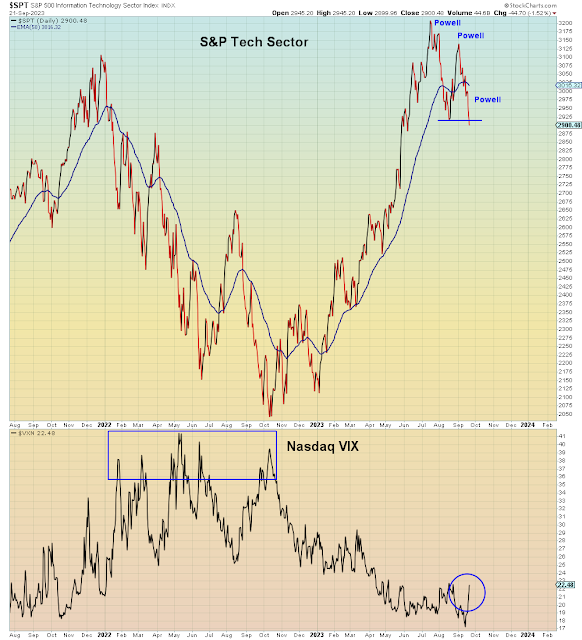The reign of complacency has continued to the end of September, despite the fact that the market peaked two months ago at the end of July. So as we enter the infamous month of October, it falls on those of us who can still fog a mirror to ask, what could go wrong?
Going back one year, stocks bottomed last October on the premise that the Fed was done or near done raising interest rates. There have been two rate pauses subsequently, but overall interest rates have continued to rise.
Throughout the past year, consumers have continued to spend due to the inflationary impulse. In an inflationary paradigm, consumers believe that their increasing debts will be offset by rising wages. Unfortunately, interest rates have risen far faster than wages, which means that the debt burden has increased over the past year, NOT decreased. Which means that they are now trapped with higher debt levels AND higher interest rates at all time low unemployment. Once the deflationary impulse returns, they will be buried under a mountain of unaffordable debt. One can presume that they will not be happy to have been led to believe that the economy is strong.
Meanwhile, the entire stock market rally has taken place under a backdrop of declining profits and rising real interest rates. The worst case scenario for stocks.
Homebuilder stocks are a prime example of the mis-pricing of risk. One year ago, these stocks took off with yields at cycle high on the premise that bond rates were coming down. But since that time, bond yields have gone up.
WSJ: Rising Rates Finally Catch Up With Homebuilder Stocks
I've been showing this same chart all year, showing homebuilders rallying against the backdrop of Fed rate hikes, but nothing mattered.
Until they spontaneously exploded.
This positive correlation between homebuilders and interest rates doesn't seem to make any sense until we look back at the 2007 housing bubble. Then as now, home prices actually rose during the rate hiking cycle and then rolled over when rates came down. Why? Because the economy was imploding.
We can expect the same thing to happen now.
This past week, Zerohedge posited that a "bounce" is due at any time. They also believe that non-Tech stocks will lead the rally from this point forward. I agree that an oversold bounce could occur at any time, but the experience of Y2K informs us that it won't last long. When the Dotcom bubble burst, "short duration" cyclicals outperformed growth stocks on a relative basis, but they still declined on an absolute basis.
In other words, bulls are watching the Tech bubble implode and yet STILL making up excuses to own stocks.
In summary, anyone with amnesia can make up excuses to own stocks right now. But you don't have to just forget 2008 and Y2K, you also have to forget last year when that bear market started the exact same way it's resuming right now. I have yet to read one bullish pundit making year-over-year comparisons. Why? Because if they did they would be forced to conclude that we are heading for the first back to back yearly bear markets since the 1930s. And that their totally fabricated rate pause "bull market" has now reversed back to the breakout level.
So it is that I make a bold prediction. That by the end of October we are challenging the lows from last October as if nothing had even happened for the past year.
Because guess what, nothing did happen.
























